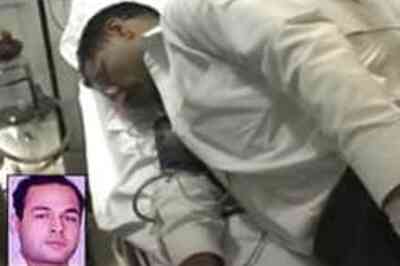
views
The BJP and RSS-VHP are engaged in a familiar push-pull routine vis-à-vis the Ram Mandir. Prime Minister Narendra Modi hints that if the Supreme Court verdict in the Ayodhya case doesn't go Ram Lalla's way, an enabling legislation is on the cards. The RSS doesn't buy the assurance and pleads that it be done in the here and now, without waiting on the convenience of the apex court.
Are they on the same page and will the endgame for 2019 Lok Sabha polls be played with or without the Ram Mandir? The short answer is that the issue is on the table now and there is no wishing it away. The PM may stick to his stance and refuse to short-circuit the legal process with a legislative measure, but the RSS, through its foot soldiers, will continue to publicly put pressure on him.
The Shiv Sena's Uddhav Thackeray is doing just that; first, by appearing in Ayodhya just before the VHP's Dharam Sansad in November and then, by taunting the PM for his let's-wait-for-the-court remark. As for the VHP, it is no longer the force it was in NDA-1, thanks to the passing of Ashok Singhal and recent internal disputes, but it did manage to create a buzz by swamping Delhi in a sea of saffron last month. Whether the buzz will translate into actual mobilisation depends on the RSS assessment of sentiment on the ground.
There is something to be said for the PM's stance. He has put the 2002 Gujarat riots behind him and found general acceptance globally and so, would not want to be seen as interfering in the judicial process to promote a majoritarian agenda. Besides, a pre-emptive ordinance may be seen as jumping the gun.
After all, the Supreme Court will have to take note of the fact that the Sunni Waqf Board's suit (no. 4) for possession was declared time-barred by the Allahabad High Court, whereas that of Ram Lalla suffers no such legal infirmity.
A section of the BJP feels that the Ram Janmabhoomi issue, one way or another, will not impact the outcome of general elections. They prefer to focus on the development agenda and attribute the loss in the recent assembly elections to organisational glitches, turf wars and anti-incumbency.
Another section feels that development and welfare measures will not cut any ice with voters and Hindu consolidation around Ram Temple will make the difference between victory and defeat. Interestingly, the powers-that-be appear to be aligned with the former group.
The big takeaway from the PM-RSS exchange is that a Ram Mandir is inevitable and a BJP-led government is the best bet for making it happen. The only question is whether it materialises sooner or later.
Thus, the PM made it a point to stress that the charge against the Mandir was being led by “Congress” lawyers. He said efforts were being made to delay the case, referring to Kapil Sibal's failed attempt to get the hearings deferred until after the Lok Sabha elections.
The RSS-VHP agenda is clearly to put the Congress on the defensive by bringing an ordinance or a bill. Any legislation will have to seek Parliament's approval, which means the Opposition will be compelled to take a stand on the floor of the House. This in turn enables the VHP to feed the Congress-is-anti-Mandir narrative, in the wake of the Congress' recent efforts to align with majority sentiments.
On the face of it, the PM's reluctance to accede to the RSS demand for an immediate legislation echoes Atal Bihari Vajpayee's face-off with the VHP in 2002. So determined was Vajpayee not to force the issue that he reportedly threatened to resign and call for an early election. Thanks to the efforts of the then RSS number three, Madan Das Devi, the irascible Ashok Singhal was persuaded to stand down.
The RSS has experienced the advantages of having a BJP government in place, far more than it did in NDA-1, when Vajpayee followed a clear arms-length principle. It is certainly invested in the outcome of Lok Sabha 2019 and will seek to whip up sentiments around Ram Janmabhoomi.
The future strategy will doubtless figure in its discussions at Chennai this week, after the Supreme Court decides to fix the date for hearing arguments in the case, involving some 14 petitions.
(Author is a senior journalist. Views are personal)


















Comments
0 comment